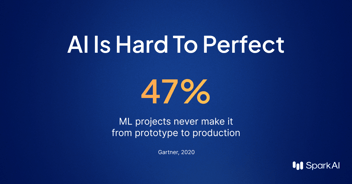Removing the Biggest Obstacle to AI Launch and Scale
4 approaches to AI edge cases – the serious speed, cost, and accuracy tradeoffs
.png)
Global investments in AI topped $93 billion in 2021. But disconcertingly, surveys of AI business leaders continue to report extremely high AI failure rates ranging between 83% and 92%.
The reality is that many AI products never make it to production, and those that do, often fail.
We know why it’s happening.
Edge Cases – A Critical Point of AI Failure
We’ve discussed the definition and the impact of critical AI edge cases in more detail here, here, and here.
But if you’re just learning about edge cases, here’s what you need to know:
- Though AI products are trained for a variety of circumstances, the unstructured environments in which they operate – farm fields, warehouses, sidewalks, or inside homes – are inherently unpredictable. This makes it impossible to train for the long-tail of all unexpected scenarios, known simply as “edge cases.”
- Edge cases cause problems. Even the most advanced AI systems struggle to reason through the unexpected. AI is missing cognition, and we are several groundbreaking innovations away from AI that can independently make its way through every novel situation it encounters.
- With AI product viability, reliability, scalability, and safety at stake, the edge case problem exposes AI’s cognitive gap and represents a critical barrier to launch & scale. To deploy AI products today, a solution for overcoming edge cases is required, not “nice to have.” AI cannot survive in the real-world without it.
4 Ways to Remove The Edge Case Obstacle
The four most common approaches are:
- Staying in R&D mode (The “leave-the-lab-later-or-maybe-never” approach)
- Remote piloting (The “RC car” approach, reserved for robots)
- Building in-house edge case resolution platform (The “non-core, expensive, distracting” approach)
- Buying an edge case resolution platform (The SparkAI way)
There are serious tradeoffs to evaluate. Selecting an approach to the edge case problem is a business-level decision that should be carefully considered.
To simplify, we’ve boiled the approaches down in this simple comparison chart:
-png.png?width=730&height=411&name=Edge%20Cases%20Graphic%20Title%201%20(2)-png.png)


